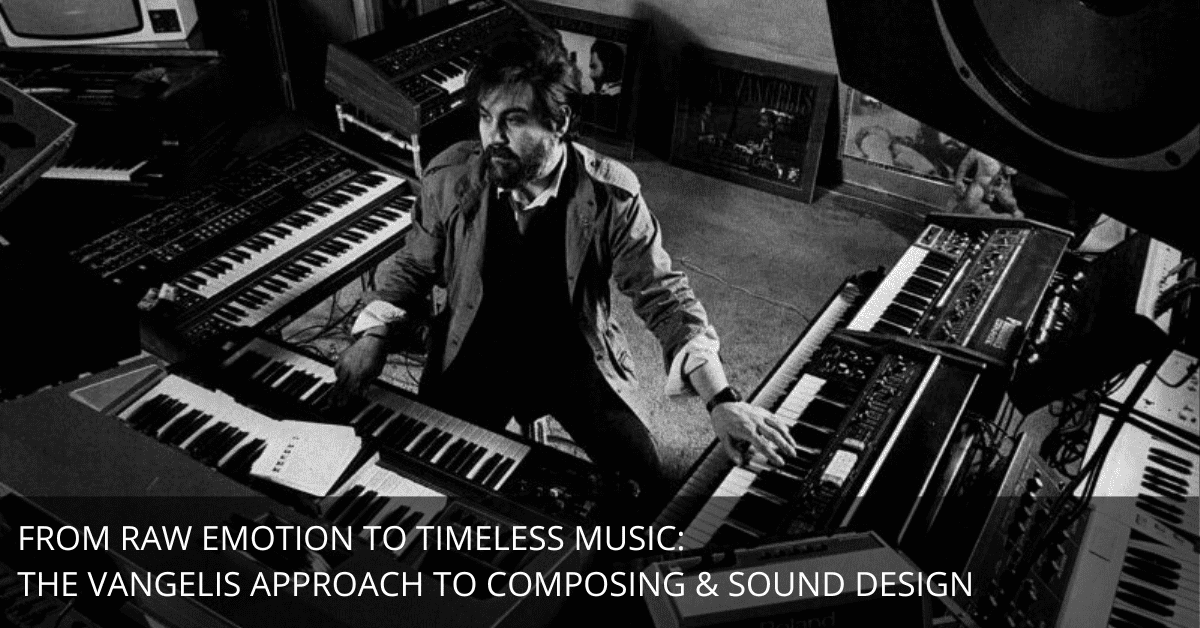
Vangelis, the musical genius behind iconic scores like Blade Runner and Chariots of Fire, didn’t just create music—he created worlds.
His secret? A laser focus on emotion, spontaneity, and treating sound as a living, breathing entity. If you’re a musician or sound designer, you can learn a lot from how he worked.
But don’t just admire his genius—apply it. Here’s how you can compose and design sounds like Vangelis, capturing authentic emotion and unlocking your creativity in real-time.
Start with Emotion—It’s the Core of Everything
Music without emotion is like a movie without a plot. It might look good on the surface but won’t leave an impact. Vangelis knew this better than anyone. His music made you feel something, whether it was awe, tension, or pure joy.
Here’s how to get started:
- Before you touch a single key or knob, ask yourself, What do I want my listener to feel? Write it down. Be specific.
- Instead of “I want them to feel sad,” think, “I want them to feel the kind of sadness you feel when watching the rain after a hard goodbye.”
- Build your composition around this emotion. Use minor chords for melancholy, swells for intensity, or a steady rhythm for determination.
- Keep asking, Does this section make me feel what I’m aiming for? If not, strip it back and rework it.
For example, in Vangelis’ “Conquest of Paradise,” the soaring vocal lines and layered synths create a feeling of triumph. You can almost see explorers braving the unknown. That emotional impact didn’t happen by accident—it was intentional.
Embrace Spontaneity—Let the Magic Happen
Vangelis famously composed in real-time, improvising entire scores without rigid plans. This spontaneity gave his music a natural, unforced quality.
Here’s what to do next:
- Set aside time to create without overthinking. Open your DAW, power up your synths, or grab your instrument and just play.
- Record everything. The best ideas often come when you’re not trying too hard.
- Turn off distractions. Put your phone on silent, close unnecessary tabs, and focus. Treat this time as sacred.
You might stumble onto a melody that gives you goosebumps or a chord progression that makes everything click. Keep chasing those moments.
Treat Sound as a Living Entity
For Vangelis, sound wasn’t just a tool—it was a character in the story. Every synth, every pad, every texture had its own personality.
Here’s how to do it:
- Experiment with layers and textures. Combine contrasting sounds, like a smooth analog pad with a gritty granular sample. Let them interact.
- Ask yourself, What story does this sound tell? Maybe a plucked string sounds like the ticking of a clock or a low drone feels like approaching thunder.
- Adjust dynamics and timbre to make the sound evolve. Automation can make a static synth line feel alive.
Think about Vangelis’ Blade Runner soundtrack. The synths don’t just play—they breathe. Each note feels alive, like it’s part of the dystopian world.
Use Technology, Don’t Let It Use You
With today’s tools, it’s easy to let technology take over. Vangelis never fell into that trap. He mastered his equipment but used it only to serve his vision.
Here’s how to follow his lead:
- Learn your gear inside out. Whether it’s Logic Pro, a Moog synth, or your favorite plugin, know how to make it work without slowing you down.
- Create templates for different types of projects—like film scoring, EDM, or ambient tracks. This minimizes setup time and lets you dive straight into creating.
- Don’t overcomplicate. Use only what you need for the project. If a simple piano line works, you don’t need ten layers of synths.
Compose in Real-Time—Capture Authenticity
There’s something powerful about creating in the moment. Vangelis treated the studio as his instrument, letting ideas flow freely and capturing them as they happened.
Here are three steps to start:
- Prepare your workspace. Set up your gear so everything is ready to go—midi controllers, sound banks, and tracks pre-loaded.
- Hit record before you play. Don’t overthink it. Just start playing and see where it takes you.
- Review and refine later. After the session, go back and listen for the moments that stood out. Build your composition around those gems.
Imagine you’re crafting a song inspired by the vastness of space. Start with a simple arpeggiator line. Let your hands wander, layering pads and tweaking filters as you go. You might not immediately land on the perfect melody, but you’ll capture something raw and real.
Bring It All Together
To tie all these lessons into your workflow, let’s break it down into a practical exercise:
Step 1: Set an emotion or theme for your next piece. Write it down. For example, “I want this track to feel like the excitement of discovering a hidden world.”
Step 2: Spend 30 minutes improvising melodies and harmonies that reflect this emotion. Record everything.
Step 3: Select one or two key ideas and build on them. Add layers, textures, and dynamic changes to tell a story.
Step 4: Use technology wisely. Pull up synth patches or plugins that enhance the theme, but don’t let them overwhelm the composition.
Step 5: Step back and listen. Does it make you feel what you intended? If not, strip it back and refine it until it does.
Your Turn to Create
Vangelis didn’t follow trends—he created timeless art by staying true to his vision. You can do the same. Whether you’re scoring a film, producing an album, or creating sound design for a project, focus on emotion, spontaneity, and the personality of sound.
And the next time you listen to Vangelis songs, pay attention to how they make you feel. That’s your blueprint.
Now, get in the studio. Start playing. Let the magic happen.

